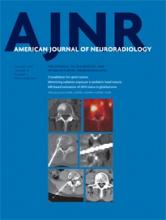Research ArticleINTERVENTIONAL
3D Printing of Intracranial Aneurysms Using Fused Deposition Modeling Offers Highly Accurate Replications
A.M.J. Frölich, J. Spallek, L. Brehmer, J.-H. Buhk, D. Krause, J. Fiehler and A. Kemmling
American Journal of Neuroradiology January 2016, 37 (1) 120-124; DOI: https://doi.org/10.3174/ajnr.A4486
A.M.J. Frölich
aFrom the Department of Diagnostic and Interventional Neuroradiology (A.M.J.F., L.B., J.-H.B., J.F., A.K.), University Medical Center Hamburg-Eppendorf, Hamburg, Germany
J. Spallek
bTechnical University Hamburg-Harburg (D.K., J.S.), Institute of Product Development and Mechanical Engineering Design, Hamburg, Germany.
L. Brehmer
aFrom the Department of Diagnostic and Interventional Neuroradiology (A.M.J.F., L.B., J.-H.B., J.F., A.K.), University Medical Center Hamburg-Eppendorf, Hamburg, Germany
J.-H. Buhk
aFrom the Department of Diagnostic and Interventional Neuroradiology (A.M.J.F., L.B., J.-H.B., J.F., A.K.), University Medical Center Hamburg-Eppendorf, Hamburg, Germany
D. Krause
bTechnical University Hamburg-Harburg (D.K., J.S.), Institute of Product Development and Mechanical Engineering Design, Hamburg, Germany.
J. Fiehler
aFrom the Department of Diagnostic and Interventional Neuroradiology (A.M.J.F., L.B., J.-H.B., J.F., A.K.), University Medical Center Hamburg-Eppendorf, Hamburg, Germany
A. Kemmling
aFrom the Department of Diagnostic and Interventional Neuroradiology (A.M.J.F., L.B., J.-H.B., J.F., A.K.), University Medical Center Hamburg-Eppendorf, Hamburg, Germany

References
- 1.↵
- Papagiannaki C,
- Spelle L,
- Januel AC, et al
- 2.↵
- Brinjikji W,
- Murad MH,
- Lanzino G, et al
- 3.↵
- 4.↵
- 5.↵
- Chueh JY,
- Wakhloo AK,
- Gounis MJ
- 6.↵
- Wetzel SG,
- Ohta M,
- Handa A, et al
- 7.↵
- 8.↵
- 9.↵
- Wohlers T
- 10.↵
- Gibson I,
- Rosen D,
- Stucker B
- 11.↵
- Wurm G,
- Lehner M,
- Tomancok B, et al
- 12.↵
- 13.↵
- Ahmed K,
- Keeling AN,
- Fakhry M, et al
In this issue
American Journal of Neuroradiology
Vol. 37, Issue 1
1 Jan 2016
Advertisement
A.M.J. Frölich, J. Spallek, L. Brehmer, J.-H. Buhk, D. Krause, J. Fiehler, A. Kemmling
3D Printing of Intracranial Aneurysms Using Fused Deposition Modeling Offers Highly Accurate Replications
American Journal of Neuroradiology Jan 2016, 37 (1) 120-124; DOI: 10.3174/ajnr.A4486
0 Responses
Jump to section
Related Articles
- No related articles found.
Cited By...
- Current and future usefulness and potential of virtual simulation in improving outcomes and reducing complications in endovascular treatment of unruptured intracranial aneurysms
- Evaluation of a modular in vitro neurovascular procedure simulation for intracranial aneurysm embolization
- A new method to statistically describe microcatheter tip position in patient-specific aneurysm models
This article has not yet been cited by articles in journals that are participating in Crossref Cited-by Linking.
More in this TOC Section
Similar Articles
Advertisement











